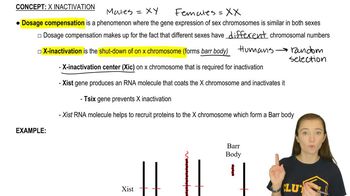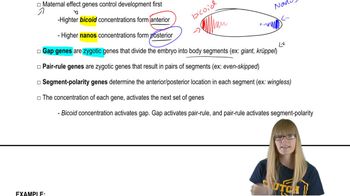Table of contents
- 1. Introduction to Genetics51m
- 2. Mendel's Laws of Inheritance3h 37m
- 3. Extensions to Mendelian Inheritance2h 41m
- 4. Genetic Mapping and Linkage2h 28m
- 5. Genetics of Bacteria and Viruses1h 21m
- 6. Chromosomal Variation1h 48m
- 7. DNA and Chromosome Structure56m
- 8. DNA Replication1h 10m
- 9. Mitosis and Meiosis1h 34m
- 10. Transcription1h 0m
- 11. Translation58m
- 12. Gene Regulation in Prokaryotes1h 19m
- 13. Gene Regulation in Eukaryotes44m
- 14. Genetic Control of Development44m
- 15. Genomes and Genomics1h 50m
- 16. Transposable Elements47m
- 17. Mutation, Repair, and Recombination1h 6m
- 18. Molecular Genetic Tools19m
- 19. Cancer Genetics29m
- 20. Quantitative Genetics1h 26m
- 21. Population Genetics50m
- 22. Evolutionary Genetics29m
2. Mendel's Laws of Inheritance
Sex-Linked Genes
Problem 34
Textbook Question
Duchenne muscular dystrophy (DMD; OMIM 310200) and Becker muscular dystrophy (BMD; OMIM 300376) are both X-linked recessive conditions that result from different mutations of the same gene, known as dystrophin, on the long arm of the chromosome. BMD and DMD are quite different clinically. DMD is a very severe disorder that first appears at a young age, progresses rapidly, and is often fatal in the late teens to 20s. BMD, on the other hand, is much milder. Often symptoms don't first appear until the 40s or 50s, the progression of the disease is slow, and fatalities due to BMD are infrequent. Go to https://www.ncbi.nlm.nih/omim and survey the information describing the gene mutations causing these two conditions. Discuss the information you find with a few others in a small group, and write a single summary explaining your findings.
 Verified step by step guidance
Verified step by step guidance1
Access the OMIM (Online Mendelian Inheritance in Man) database by navigating to https://www.ncbi.nlm.nih.gov/omim.
Search for the entries corresponding to Duchenne muscular dystrophy (DMD; OMIM 310200) and Becker muscular dystrophy (BMD; OMIM 300376) to locate detailed information about the dystrophin gene mutations.
Review the descriptions of the dystrophin gene (DMD gene) mutations for both conditions. Note that DMD is caused by mutations that typically result in a complete loss of dystrophin protein, while BMD is caused by mutations that allow for the production of a partially functional dystrophin protein.
Compare the clinical differences between DMD and BMD based on the severity of the mutations. DMD mutations are often frameshift or nonsense mutations leading to truncated, nonfunctional dystrophin, whereas BMD mutations are usually in-frame deletions that preserve some dystrophin function.
Summarize your findings in a concise explanation, highlighting the genetic basis of the differences in severity and progression between DMD and BMD. Discuss these findings with your group to ensure a comprehensive understanding before finalizing the summary.
 Verified video answer for a similar problem:
Verified video answer for a similar problem:This video solution was recommended by our tutors as helpful for the problem above
Video duration:
2mPlay a video:
Was this helpful?
Key Concepts
Here are the essential concepts you must grasp in order to answer the question correctly.
X-linked Recessive Inheritance
X-linked recessive inheritance refers to genetic conditions that are associated with mutations on the X chromosome. Males, having only one X chromosome, are more likely to express these conditions if they inherit a mutated gene, while females, with two X chromosomes, may be carriers without showing symptoms. This pattern of inheritance is crucial for understanding conditions like Duchenne and Becker muscular dystrophy.
Recommended video:
Guided course

X-Inactivation
Dystrophin Gene and Its Role
The dystrophin gene encodes a protein essential for maintaining the structural integrity of muscle cells. Mutations in this gene lead to the absence or dysfunction of dystrophin, resulting in muscle degeneration seen in conditions like DMD and BMD. Understanding the specific mutations and their effects on dystrophin is key to differentiating between the severity of these two muscular dystrophies.
Recommended video:
Guided course

Segmentation Genes
Clinical Manifestations of DMD and BMD
Duchenne muscular dystrophy (DMD) and Becker muscular dystrophy (BMD) exhibit distinct clinical manifestations despite being caused by mutations in the same gene. DMD typically presents severe symptoms early in life, leading to rapid progression and early mortality, while BMD has a milder course with later onset and slower progression. Recognizing these differences is essential for diagnosis and management of the conditions.
Recommended video:
Guided course

Modern Genetics
Related Videos
Related Practice
Textbook Question
In a cross in Drosophila involving the X-linked recessive eye mutation white and the autosomally linked recessive eye mutation sepia (resulting in a dark eye), predict the F₁ and F₂ results of crossing true-breeding parents of the following phenotypes:Note that white is epistatic to the expression of sepia.white females x sepia males
1459
views


